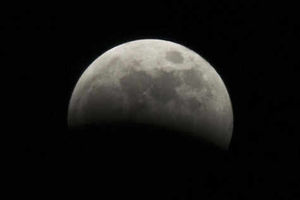Lunar eclipse to be visible this weekend
A lunar eclipse will be visible from the West Midlands this weekend – for 25 minutes. Tomorrow, the sun, Earth and moon will fall almost exactly in line.

A lunar eclipse will be visible from the West Midlands this weekend – for 25 minutes. Tomorrow, the sun, Earth and moon will fall almost exactly in line.
The result should produce a special celestial spectacle, with the satellite appearing a brilliant red. But that will happen only for those who head for the Shetland Islands and find a good horizon and good weather waiting for them.
For sky watchers in the West Midlands the best they can hope for is a partial eclipse with the moon in the Earth's shadow.
Nonetheless, they will not get another chance to see anything like it until 2015.
The phenomenon will be most dramatic in East Asia, Australasia and the western Pacific.
Dr Robert Massey, of the Royal Astronomical Society (RAS), said that in the West Midlands the phenomenon would begin at 3.53pm with moonrise.
The last that anyone in the region will see of the eclipse will be at 4.18pm.
Dr Massey said: "For the West Midlands it's a very brief window indeed. It will look as though the moon is in shadow. If you want the best chance of seeing it you should try to have a north-west horizon in view."
The last such eclipse was in 2008.
Those living in Lerwick, in the Shetland Islands, are expected to see moonrise at 2.54pm, so may just be able to glimpse the red satellite very low on the horizon.
"It will literally just be for one or two minutes but even that is a bit uncertain because it all depends on the time the moon rises, which is in itself a bit unpredictable," Dr Massey added.
"But eclipses are spectacular and it is certainly worth a bit of time to go and look at it." A total lunar eclipse occurs when the full moon moves into the Earth's shadow.
Although it becomes dimmed, the moon can still be seen because it is lit by the sunlight passing through our planet's atmosphere. As it moves into the darkest part of the shadow, or umbra, it will assume a grey or red colour.





